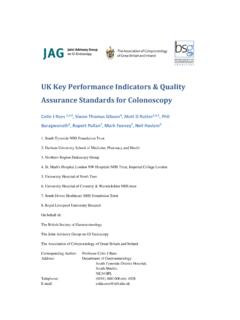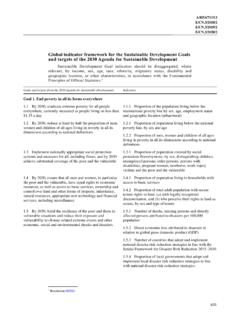Transcription of Nutrition Targets and Indicators for the - UNSCN
1 Nutrition Targets and Indicators for the Post-2015 Sustainable Development Goals Accountability for the Measurement of Results in Nutrition A Technical Note February 2015 Nutrition Targets and Indicators for the SDGs 2 ACKNOWLEDGEMENTS This paper was written by Eline Korenromp PhD, Futures Institute and Marzella W stefeld PhD, UNSCN Secretariat. Inputs were generously provided by colleagues from the Food and Agriculture Organization, World Food Programme and World Health Organization. In addition, contributions are acknowledged from Monika Barbara Bloessner, Jessica Fanzo, Patrizia Fracassi, Helen Connolly, Jennifer Coates, Lawrence Haddad, Barrie Margetts, Rebecca Olson, Fred Arnold, Patrick Webb, and Janice Meerman.
2 The UNSCN Secretariat wishes to thank all for their support and advice. The funding by the Government of the Federal Republic of Germany, through BMEL, is gratefully acknowledged. This report is also available at the UNSCN website at Nutrition Targets and Indicators for the SDGs 3 Table of Contents 1. INTRODUCTION Nutrition is integral to Sustainable Development The MDG agenda is incomplete The Nutrition landscape has changed Nutrition and the Sustainable Development Goals 2. Targets AND Indicators Priority Nutrition Targets and Indicators for the SDGs Other optional Indicators of significant importance Intervention coverage Indicators for country-level monitoring Key Messages 3.
3 ACCOUNTABILITY FOR THE MEASUREMENT OF RESULTS IN Nutrition Measurement and Information Systems Accountability for Results Key Messages ANNEX Annex 1: Rational for inclusion of all six WHA Targets in the SDGs Annex 2: Data collection systems for Nutrition measurement Annex 3: Measurement systems and current data tracking status for global Nutrition Targets Annex 4: Coverage Indicators of Nutrition -specific interventions Annex 5: List of Abbreviations Annex 6: References. Nutrition Targets and Indicators for the SDGs 4 I) INTRODUCTION Nutrition is integral to sustainable development Nutrition is to be understood as both an input to and an outcome of sustainable development.
4 Malnutrition -which includes several forms of undernutrition as well as overweight and obesity- derives not just from a lack of food, but from a host of interacting processes linking health, care, education, sanitation and hygiene, access to resources, women s empowerment and more. The choices that individuals make regarding what foods to produce and market, what diets their families consume, and the care and nurture of nutritionally vulnerable people (particularly mothers and infants), all have a direct bearing on Nutrition outcomes. At the individual level good Nutrition is necessary for achieving optimal physical and mental development during childhood, and has been linked to improved academic performance and higher wage rates during adolescence and adulthood.
5 At population level, these benefits support increased economic growth and welfare gains, two sustainable development requisites. Conversely, poor Nutrition impairs labour productivity, which in turn impedes national economic growth. Without appropriate investments and action, poor Nutrition contributes to the global burden of disease, impairs quality of life, and acts as a brake on economic growth worldwide. In this sense, malnutrition poses a pernicious, often invisible, impediment to achieving all the Post-2015 Sustainable Development Goal (SDG) Targets .
6 As such, the Nutrition community, and its natural allies in the food systems, agriculture, WASH, gender, social protection and health communities, are advocating for action oriented, measurable Targets for improved Nutrition within the SDG framework [1]. This technical note encourages dialogue on Targets and related Indicators to monitor, report on and account for progress towards improved Nutrition across the post-2015 agenda. The note is organized as follows: The rest of this introduction provides background on the Millennium Development Goals, changes in the Nutrition landscape over the last decade, and the suggested SDGs.
7 The following section covers proposed global Nutrition Targets and Indicators ; embedding Nutrition Indicators in the SDGs; and intervention coverage Indicators for country-level monitoring. The final section addresses the issue of accountability, first with regards to ensuring that data collection and national information systems can accurately measure progress in Nutrition by providing high quality , timely and disaggregated data; and second with a discussion of national cost estimates and tracking of resources for Nutrition . The MDG agenda is incomplete In the year 2000, world leaders adopted the Millennium Declaration and agreed on a set of eight Millennium Development Goals (MDGs) to be met by September 2015.
8 MDG1 brought attention to the need to improve food and Nutrition security (Goal 1C: to halve the proportion of people who suffer from hunger) [2], with its two Indicators for monitoring progress: indicator Prevalence of underweight children under-five years of age; and indicator Proportion of population below minimum level of dietary energy consumption. A more colloquial and commonly used term for this latter indicator is undernourishment (SOFI 2013). Overall, however, the MDG Nutrition focus was minimal. Moreover, without having specified how to achieve the Nutrition - and other - Targets , country ownership of the goals was hamstrung.
9 To date, while unprecedented progress has been made in poverty eradication and human development, many of the Targets , including MDG-1C, are far from being achieved. Nutrition Targets and Indicators for the SDGs 5 Lessons learnt from the MDG framework specific to Nutrition include the realization that the focus on undernutrition was too narrow, and that synergies between Nutrition and other sectors were underexploited. For example, many national Nutrition strategies in the 2000s focused almost exclusively on treatment of acute malnutrition (wasting).
10 Anchored in ministries of health, these strategies often did little to encourage food based approaches to reducing malnutrition. In many countries, the disconnect was further exacerbated by food security policies whose primary objective was increased production of staple grain [3]. Today, in contrast, a huge body of knowledge exists on the multi-sectoral approach , including holding the food and agriculture sectors accountable for Nutrition [4]. It is important to note that the uni-sectoral approach which fragmented Nutrition strategy in the 2000s not only limited progress toward the achievement of MDG1 Targets , but probably also slowed progress in achieving other related Targets such as poverty reduction, education, child mortality and maternal health [5].










